Want to boost your cooking game and savor the outdoors? A kitchen garden is your answer! Big yard or tiny balcony, growing your own food is easier than you think. Discover 27 inspiring kitchen garden ideas to create your personal green haven at home. Start growing fresh herbs, veggies, and fruits today!
Raised Bed Gardening Benefits
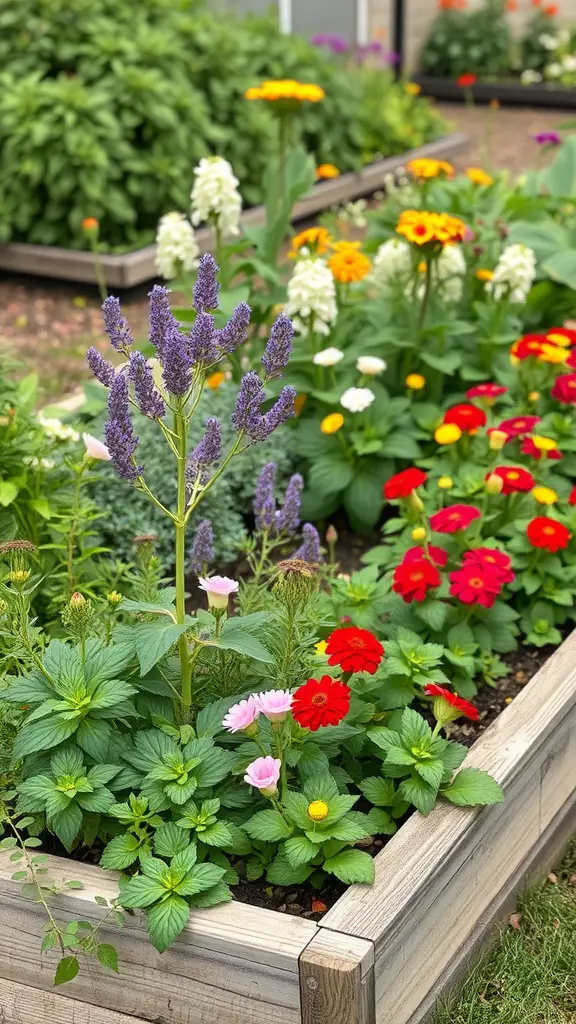
Elevated garden beds provide an easy and efficient method for cultivating plants at home. The picture showcases a lively raised bed bursting with bright flowers and verdant foliage. This design is visually attractive and highly functional.
Raised garden beds offer a key advantage: enhanced soil drainage. Elevating your plants allows surplus water to escape quickly. This is particularly beneficial in regions prone to waterlogged soil. Consequently, your plants face a reduced risk of root rot, promoting healthier growth.
A key benefit is superior soil management. Tailor your raised bed’s soil blend to perfectly match your plants’ requirements. This allows you to cultivate a thriving, nutrient-dense environment, promoting robust plant development.
Raised garden beds also boost accessibility. They offer an easier reach, especially for those with mobility challenges. Plant flowers and veggies comfortably, reducing back strain and enhancing your gardening enjoyment.
Raised beds offer pest and weed control benefits. Their elevated design can deter some pests from reaching your plants. Thoughtful planning also minimizes weed growth in your garden.
Vertical Gardening Solutions
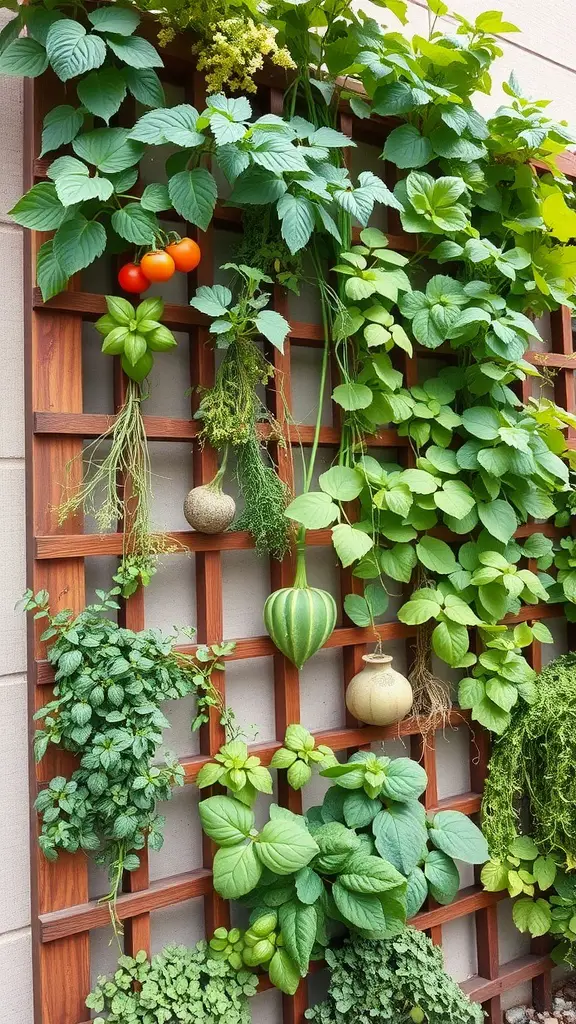
Vertical gardens offer an innovative solution for growing plants, especially when space is limited. This photo highlights a stunning wooden trellis, flourishing with diverse plant life, effectively utilizing vertical space. The lush green foliage provides a striking contrast against the wood’s natural warmth, resulting in an eye-catching display.
This garden features vibrant tomatoes growing in bunches, creating a splash of color. You’ll also find various herbs and leafy greens, ideal for cooking and enhancing your dishes. Basil and mint plants offer both aesthetic appeal and practical culinary uses.
Vertical gardening is perfect for compact areas like balconies or patios. Constructing your own vertical garden is simple. Install a trellis and select plants suited for vertical growth. Consider adding climbing plants or trailing varieties that gracefully cascade downwards.
Vertical gardening maximizes space and adds a striking design element to your outdoor area. Imagine the convenience of harvesting fresh herbs and vegetables for your culinary creations! It elevates the joy of cooking.
Seasonal Crop Rotation Strategies
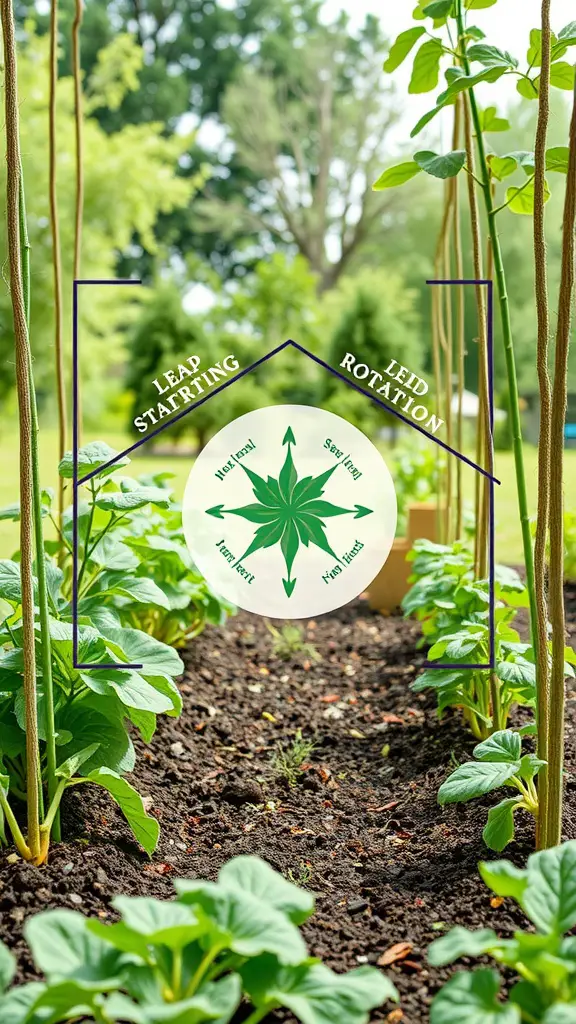
Maximize your kitchen garden’s potential by mastering seasonal crop rotation. This vital technique boosts soil health and minimizes pest issues. The image provides a clear visual guide to crop rotation, demonstrating how diverse plants flourish across different seasons.
This diagram highlights a cyclical approach. Begin with leafy greens, transition to root vegetables, and finally cultivate fruiting plants. This strategy guarantees continuous garden productivity all year long.
Crop rotation revitalizes your soil by naturally replenishing vital nutrients. Legumes, for instance, enrich the soil with nitrogen, which is highly beneficial for subsequent plantings. This smart farming technique enhances crop yields and promotes a healthier environment.
When designing your 2025 garden, remember these crop rotation methods. They’re easy to implement and will significantly improve your gardening success and yield a larger harvest.
Herb Spiral Design
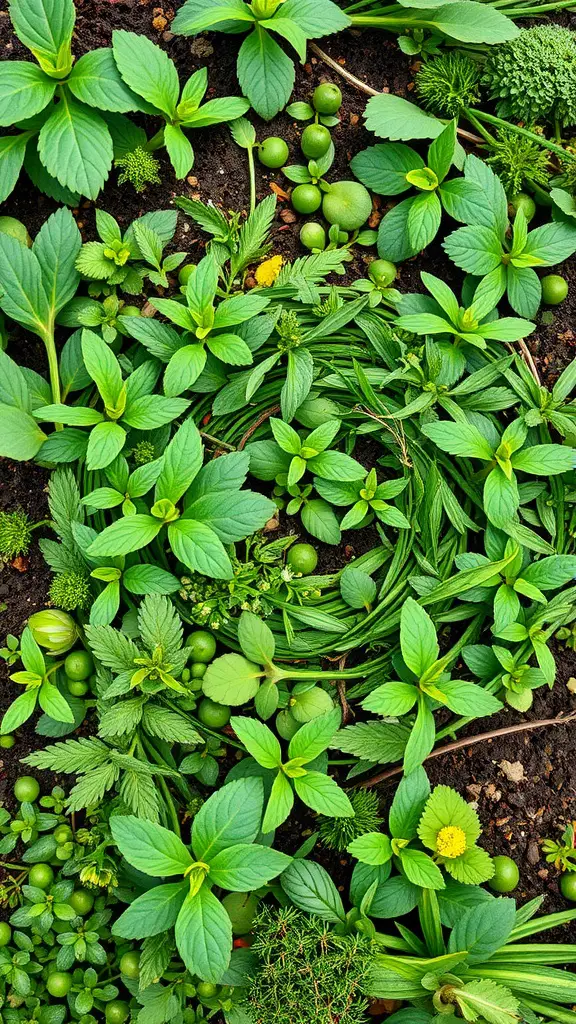
Herb spirals offer a delightful and effective method for cultivating diverse herbs in limited spaces. Their spiral design creates varied microclimates within a single garden. This innovative approach enables different herbs to flourish harmoniously in a compact setting, maximizing your yield and gardening enjoyment.
This image showcases a vibrant herb garden, bursting with diverse green hues. Mint and parsley stand out, interwoven within the spiral design. This layout is both visually appealing and optimized for sunlight and drainage.
When arranging your herbs in a spiral garden, consider their individual water requirements. Herbs positioned at the spiral’s peak will dry out faster. Conversely, those at the base will hold moisture longer. This unique design also serves as a fantastic focal point and conversation piece in your 2025 garden!
Ready to build your own herb spiral? Begin by selecting a sun-drenched location in your garden. Collect stones or bricks to construct the spiral shape. Fill it with nutrient-rich soil. Think about planting herbs such as basil, thyme, and rosemary. These herbs flourish in varying moisture levels. Savor the experience, and you’ll quickly have a stunning and practical herb garden!
Companion Planting Techniques
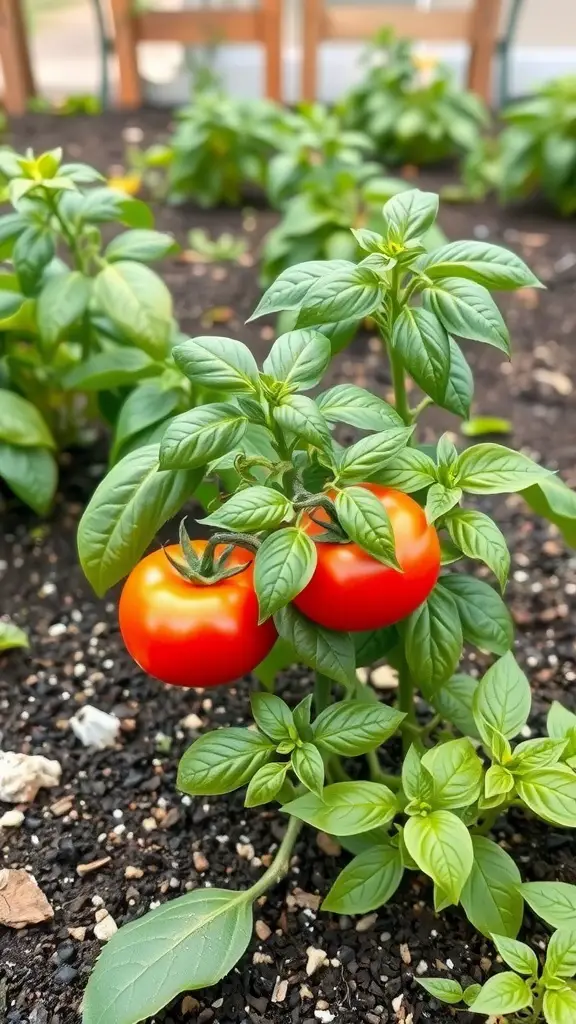
Companion planting remains a top strategy for a flourishing kitchen garden in 2025. This method involves strategically pairing plants to maximize growth and minimize problems. For instance, the image showcases robust tomatoes thriving alongside fragrant basil. This pairing is a well-known and effective companion planting technique.
Tomatoes and basil are a visually appealing combination and offer mutual advantages. Basil naturally repels pests that target tomatoes. Conversely, tomatoes offer basil shade during intense heat. This illustrates how certain plant pairings thrive synergistically.
Begin your companion planting journey by carefully planning your garden’s design. Cluster plants together that flourish under similar conditions. A prime example is pairing tomatoes and basil, as they both love warmth and abundant sunshine. Integrating them within the same garden bed optimizes space and resource utilization.
Exploring diverse combinations can yield unexpected benefits. Consider incorporating herbs such as parsley or cilantro into your tomato garden. They’ll complement each other beautifully and enhance the taste of your dishes!
Edible Landscaping Ideas
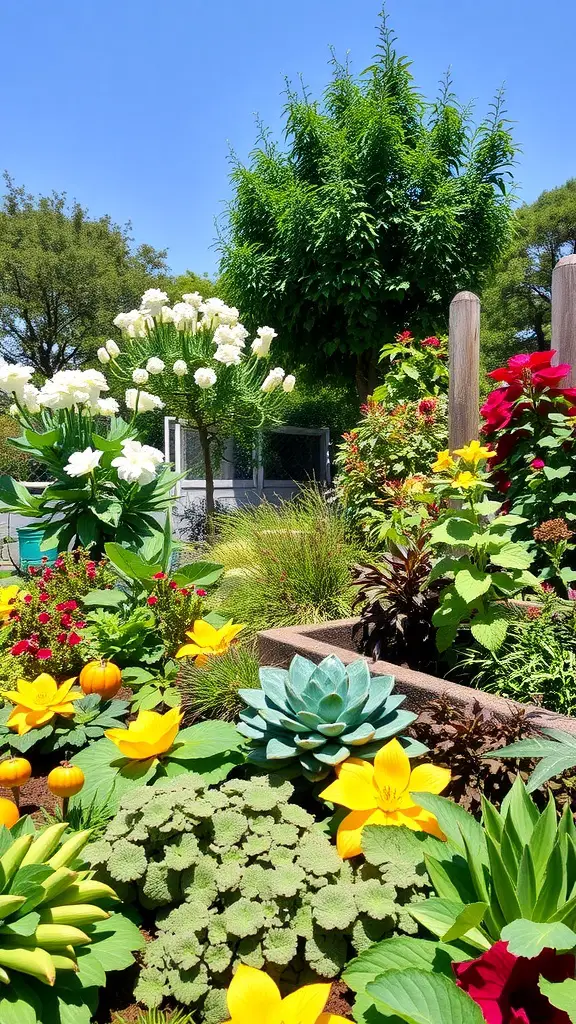
Transforming your yard into an edible paradise is both enjoyable and fulfilling. This picture perfectly shows how bright hues and diverse textures can merge, turning your garden into a feast for the eyes and the stomach.
Up front, vibrant yellow flowers and rich green foliage catch the eye. Consider pairing them with edible plants for a dual-purpose garden. Squash blossoms and nasturtiums are excellent choices. They’re delicious and bring a burst of color to your garden in 2025.
The striking blue-green succulent provides a captivating visual contrast. Although inedible, its presence alongside edible plants adds depth and elevates the garden’s overall aesthetic appeal. This layered approach enhances the garden’s beauty.
In 2025, consider integrating compact, fruit-bearing plants such as cherry tomatoes or peppers directly into your flower beds. This innovative approach yields both fresh produce and an eye-catching garden aesthetic, sparking interest and adding vibrancy.
Maximize your garden! Use vertical space effectively. Climbing plants, such as peas or beans, introduce height and visual appeal. Plus, they yield tasty harvests. Imagine a trellis adorned with vibrant green and colorful beans – a truly captivating garden centerpiece.
The secret to successful edible landscaping? Experiment! Discover combinations that inspire you. Blend diverse shapes and vibrant colors. Most importantly, enjoy creating a garden that’s both stunning and productive in 2025!
Container Gardening for Small Spaces
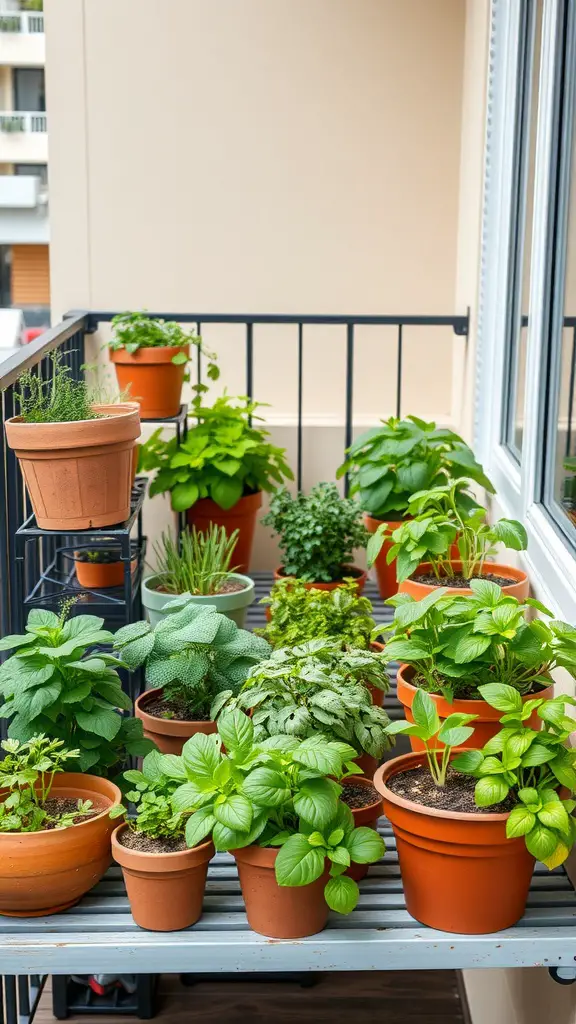
Even with limited space, container gardening offers a wonderful way to grow your own fresh food. The picture displays a charming balcony transformed into a lush green retreat with diverse potted plants. Each container bursts with vibrant life, featuring a variety of herbs and vegetables perfectly suited for compact spaces.
Maximize your space with terracotta pots and tiered shelving. Grow basil, mint, and leafy greens for beauty and flavor. This setup proves you don’t need a big yard to enjoy nature indoors.
Combining plants of diverse sizes crafts a visually stunning display. This also opens doors to culinary exploration. Imagine enhancing everyday meals with fresh herbs, readily available right outside your doorstep for ultimate convenience.
When designing your 2025 container garden, prioritize sunlight needs. Group plants with similar light requirements together. This ensures a flourishing garden is easily accessible. Limited space? Remember, a few well-chosen pots can transform your culinary aspirations into reality!
Kitchen Garden Layout Plans
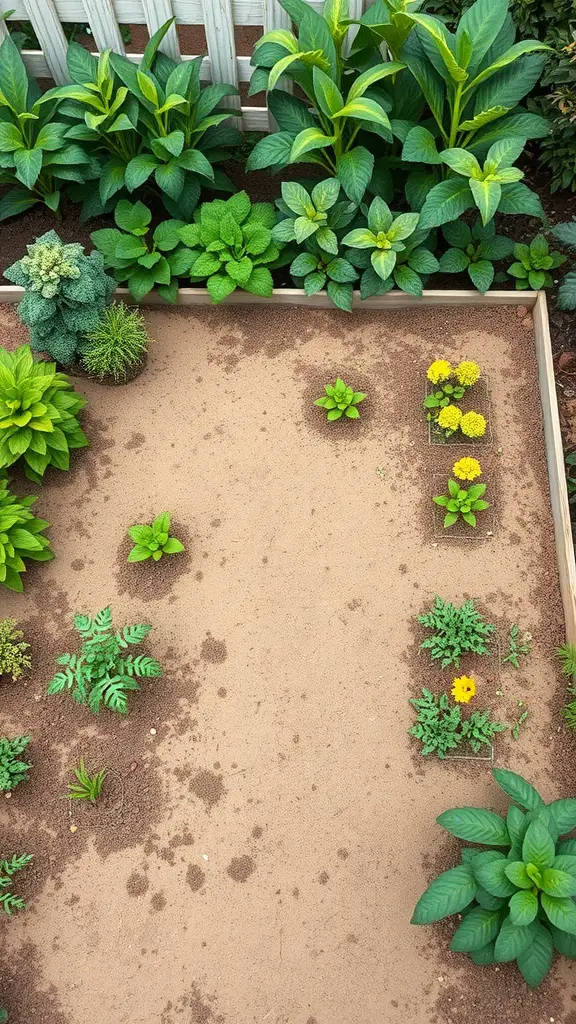
Starting a kitchen garden is incredibly fulfilling. A well-thought-out layout is essential. The image showcases a beautifully organized garden bed. It demonstrates how diverse herbs and vegetables flourish together, even in small areas.
This garden layout optimizes sunlight and airflow. Taller plants are strategically positioned at the back. Shorter plants are placed in front. This ensures all plants receive adequate light for optimal growth. The blend of leafy greens and colorful flowers enhances visual appeal. It also attracts helpful insects to your garden.
Begin with a well-defined garden layout. This helps you picture the placement of each plant. Group plants that share similar requirements for water and sunlight. Basil and cilantro, for instance, thrive together. Leafy greens should be planted in a nearby location. Remember to include walking paths for easy upkeep.
This garden design promotes companion planting, a beneficial technique. Marigolds, for example, are strategically planted near vegetables to naturally repel pests. Let this image inspire you to design your own thriving garden space at home.
Herb Garden in a Bottle

Growing herbs in a bottle garden is a delightful and innovative way to bring nature indoors. This easy technique lets you cultivate fresh herbs, even with limited space. It’s perfect for your kitchen counter or a bright windowsill.
This image showcases a glass bottle repurposed as a mini herb garden. It’s filled with soil and thriving young herbs. Notice the vibrant green leaves, promising fresh flavors. This stylish setup offers both beauty and convenient access to your favorite herbs.
Ready to create your own miniature herb garden in a bottle? You’ll need a clean glass bottle, quality potting soil, and your favorite herb seeds or small cuttings. Begin by filling the bottle’s base with soil, then carefully plant your chosen herbs. Ensure they receive ample sunlight and water them consistently. Soon, you’ll enjoy fresh, homegrown herbs perfect for enhancing your culinary creations!
Pollinator-Friendly Plant Choices
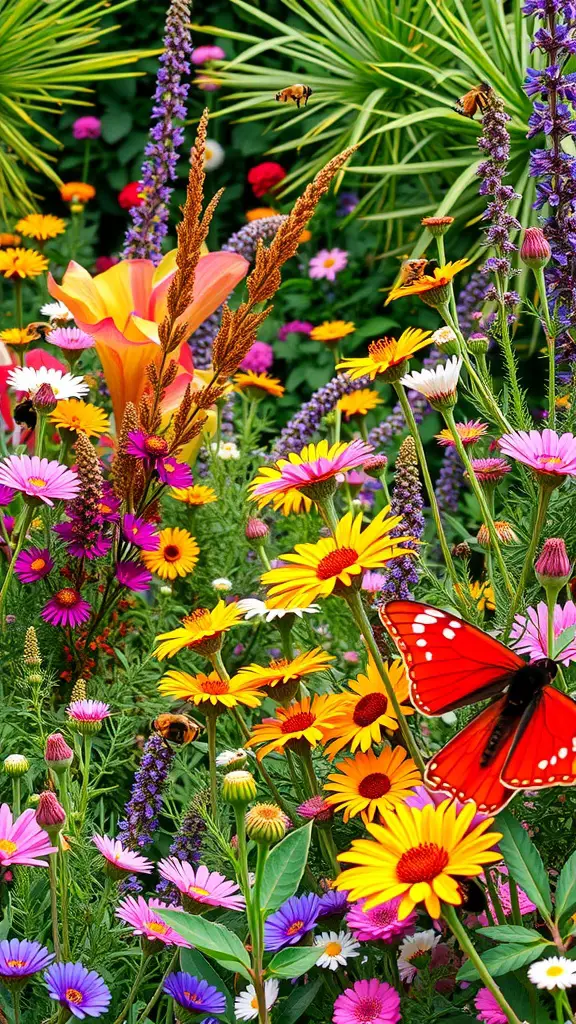
Cultivating a garden that welcomes pollinators is an excellent way to help local ecosystems and enhance your outdoor area. The picture above displays a colorful array of flowers designed to attract bees, butterflies, and other helpful insects. This supports biodiversity and adds visual appeal.
Attract pollinators by planting diverse flowers. Daisies, asters, and coneflowers are excellent choices. Their vibrant yellows and purples will enhance your garden’s beauty. Plus, they offer crucial food for bees and butterflies.
Also, think about planting native plants. They’re usually tougher and need less care. Plus, they offer a natural home for local bees and butterflies. Notice the many shapes and colors of the flowers in the picture. They give pollinators lots of options. It’s like setting up a feast for them!
Remember to incorporate plants with staggered bloom times. This guarantees continuous floral displays. A thoughtfully designed garden, as pictured, becomes a visual delight and a haven for pollinators.
DIY Trellises for Climbing Plants
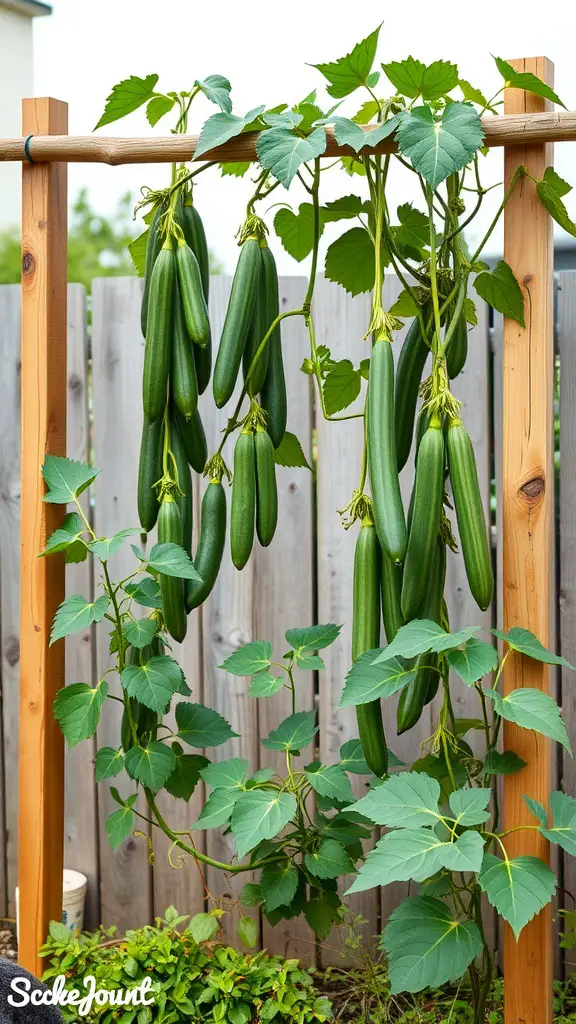
Starting a kitchen garden is incredibly fulfilling, particularly with climbing plants. Building your own trellis is an excellent way to support them. The image showcases a wooden trellis supporting thriving green cucumbers. This method saves space and promotes plant health by enhancing air flow and minimizing disease risks.
Elevate your cucumbers and climbing plants with a straightforward wooden frame. This simple trellis offers a space-saving solution for gardens of all sizes. The pictured design is both robust and visually appealing, enhancing your garden’s aesthetic.
Constructing a simple trellis involves collecting wooden posts and horizontal supports. Firmly plant them in the ground, guaranteeing they can support the plants’ weight. Incorporate string, wire, or mesh for plant attachment during growth. This weekend DIY project offers continuous advantages throughout the entire growing season.
Think about growing peas or beans with your cucumbers. This maximizes garden space and looks beautiful as your plants thrive. Picture yourself harvesting fresh cucumbers for salads directly from your trellis!
Vertical Hydroponic Systems
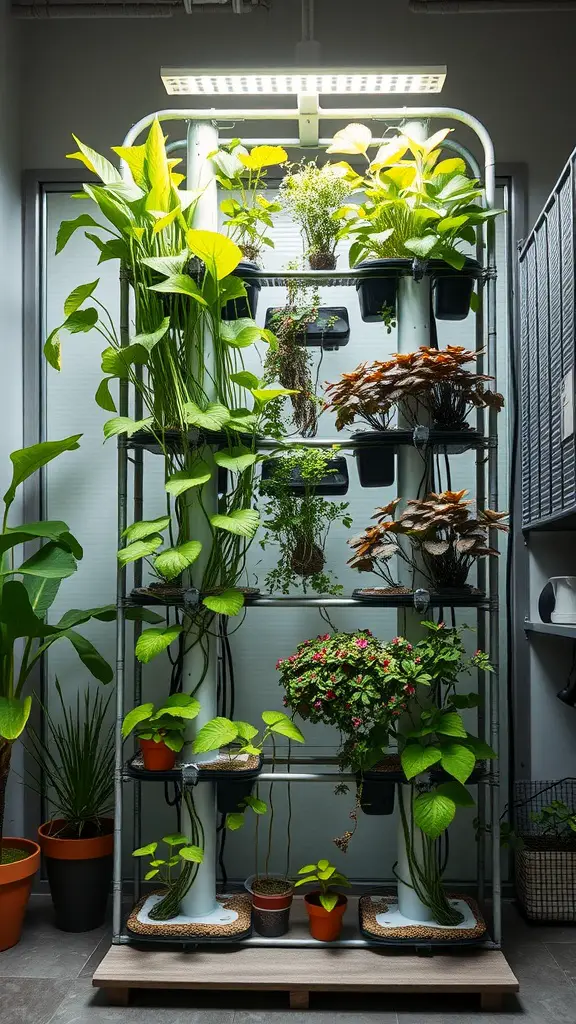
Vertical hydroponics offers a cutting-edge solution for space-efficient plant cultivation. This innovative approach lets you grow diverse plants, even without a conventional garden. The picture highlights a meticulously arranged vertical hydroponic system. It optimizes space and creates a lively, verdant setting, perfect for modern urban gardening in 2025.
This advanced system employs several tiers. It guarantees plants get sufficient light and nutrients. Observe the diverse leafy greens and herbs flourishing in their separate containers. Notice the meticulous arrangement. This design simplifies plant care and harvesting.
Illumination is key for successful hydroponics. The bright lamp in this setup guarantees ample light. This allows even the uppermost plants to perform photosynthesis efficiently. Planning a vertical hydroponic garden? Consider your plant choices carefully. Basil, mint, and other small vegetables thrive in these systems.
Keeping your vertical hydroponic garden thriving is simple. Monitor water levels and nutrient solutions frequently. Clean the system regularly to avoid buildup. This image inspires you to explore this gardening method. See how easily it fits into your home in 2025!
Companion Flowers for Vegetables
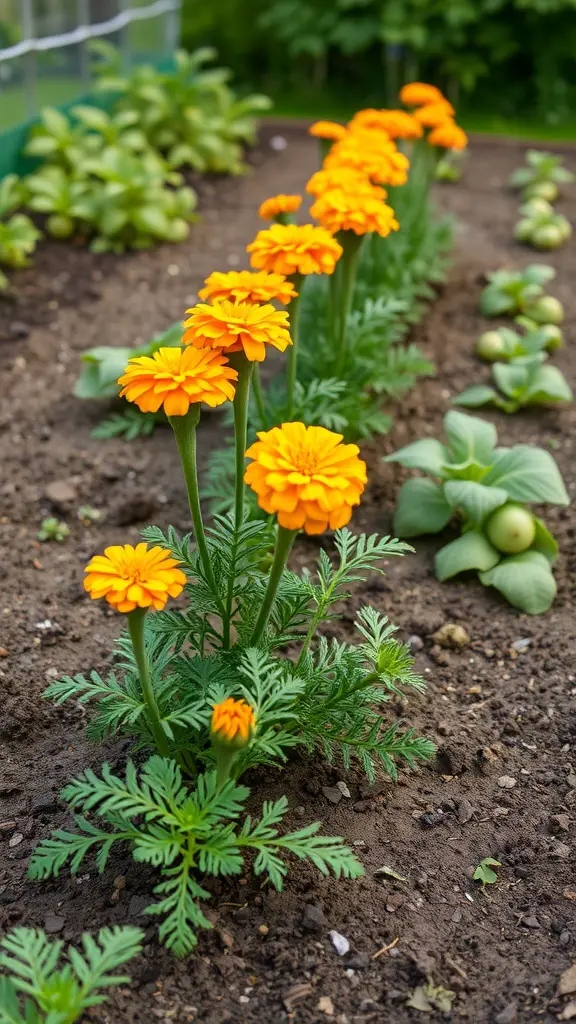
Maximize your kitchen garden’s potential with companion planting techniques. This image showcases bright marigolds, offering beauty and functionality. Marigolds naturally repel pests, protecting your valuable vegetable crops.
In this vibrant garden view, rows of marigolds stand tall, adding a splash of color to the earth. Their bright blooms sharply contrast with the lush green leaves of nearby plants. Planting these flowers alongside vegetables promotes a balanced and thriving garden ecosystem.
Marigolds are excellent companion plants for tomatoes, peppers, and squash. They draw in helpful insects and deter pests. This biological pest management reduces the need for chemical pesticides, promoting a more organic garden in 2025.
Growing marigolds in your kitchen garden is simple and beneficial. Plant them in groups close to your vegetables for an attractive and practical design. Enjoy the scenery and the advantages they offer to your growing plants.
Rainwater Harvesting for Gardens
Rainwater harvesting is a practical method for gathering and utilizing rainwater in your garden. The image illustrates a system featuring rain barrels, designed to capture water runoff from roofs or other surfaces. By using this harvested water, you can significantly reduce your water expenses and conserve valuable natural resources.
The image showcases two rainwater barrels. One is currently collecting rainwater. This straightforward system is easy to set up. It integrates seamlessly into nearly any garden. Envision having a consistent water source for your plants. You’ll reduce your dependence on the municipal water supply.
Collecting rainwater is great for your garden and the planet. It lessens runoff and fights erosion. This benefits both your plants and the environment. Setting up your own rainwater system is simple with just a few items.
Begin by positioning a rain barrel beneath a downspout or any roof section that gathers rainwater effectively. Purchase barrels from local garden supply stores or online retailers. Install a mesh screen to prevent leaves and other debris from entering. Finally, attach a spigot near the base for convenient water retrieval.
With your rainwater harvesting system installed, you’ll be surprised by how fast the barrels collect water after a significant rainfall. This collected water is perfect for all your gardening tasks, including watering flowers and irrigating your vegetable garden. It’s a simple and beneficial addition to any kitchen garden, offering numerous advantages!
Square Foot Gardening Method
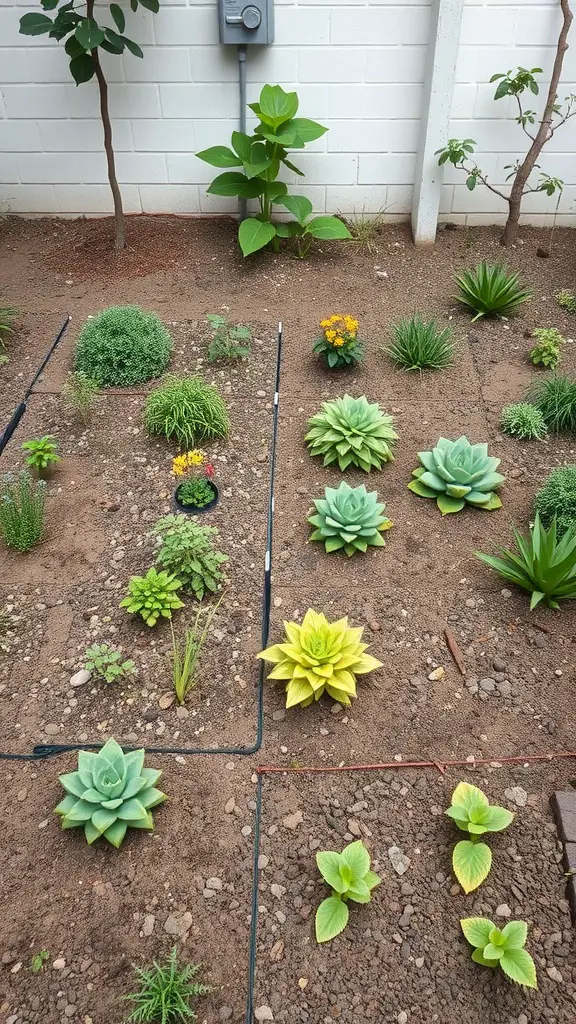
Square foot gardening is an efficient technique for cultivating diverse plants in small areas. The image showcases well-organized squares, each containing different plant varieties. This design optimizes your garden space and promotes order.
This gardening approach is fantastic because each square can grow something different – herbs, veggies, or flowers. Imagine basil and cilantro thriving in one square, while vibrant flowers bloom in another. This variety enhances your garden’s look and encourages healthier growth through plant synergy.
This picture showcases flourishing plants, a testament to the method’s success. Grid lines empower gardeners to strategically plan their planting, simplifying upkeep and harvesting. It’s an enjoyable and productive gardening technique, ideal for those with small gardens.
Transform your backyard into a thriving kitchen garden with the square foot gardening technique. Imagine harvesting fresh, delicious ingredients for your meals right outside your door!
Kitchen Garden Maintenance Tips
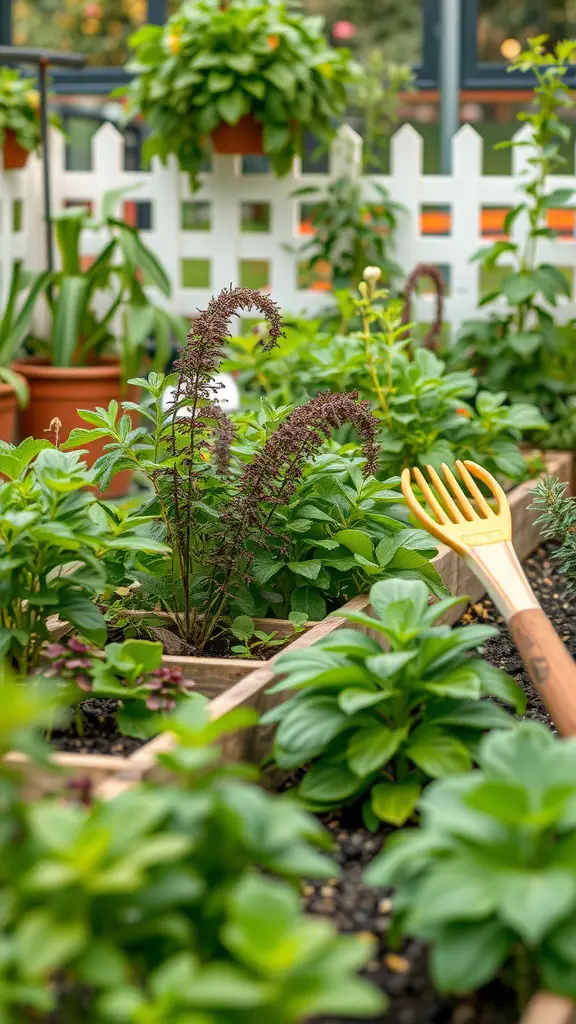
Growing your own kitchen garden is incredibly satisfying. You get to care for plants that will become fresh food on your table. The picture shows a neat garden, full of healthy green plants. A rake is there, ready for taking care of the garden.
Maintain a flourishing kitchen garden by routinely inspecting your plants for pests and diseases. Spotting problems early is crucial for preventing widespread damage. Consider using natural pest control solutions, such as garlic or neem oil sprays, to deter unwanted insects.
Effective watering is key for thriving plants. Provide adequate moisture, particularly when it’s dry. However, be careful not to overwater. A simple test: check the top inch of soil. If it feels dry, water your plants.
Boost your soil with compost! It enhances soil structure and delivers vital nutrients for robust plant growth.
Finally, remember to prune your herbs and veggies. Consistent trimming promotes fuller growth and avoids overcrowding. This allows each plant to thrive. Follow these easy maintenance tips to keep your kitchen garden healthy and productive throughout the season.
Shade Gardening for Herbs
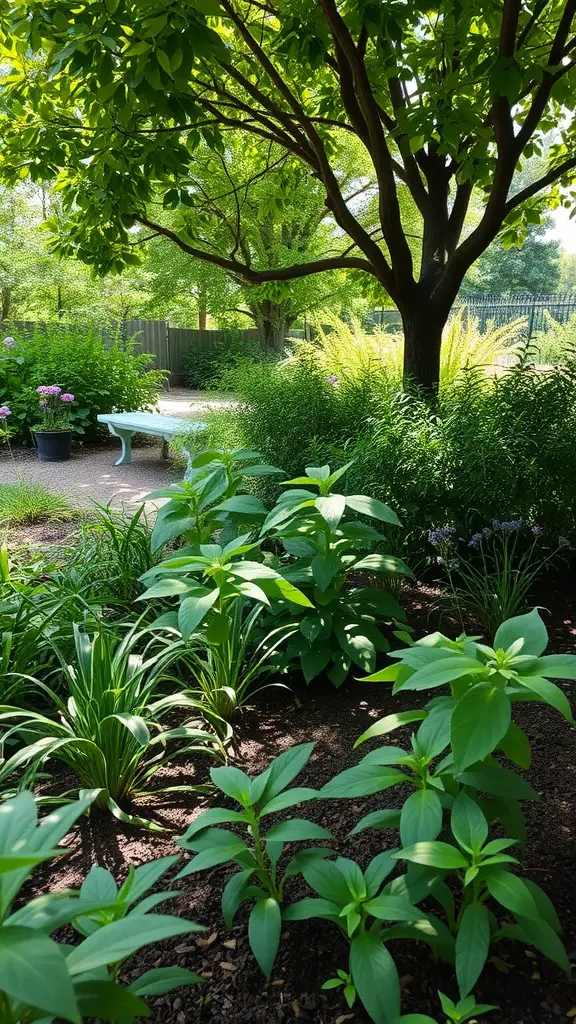
Transform your shaded areas into thriving herb gardens! Imagine lush greenery flourishing beneath the trees. This tranquil space, filled with vibrant greens, offers the ideal environment for cultivating your favorite herbs.
Observe carefully! You might discover various herbs thriving amongst the plants. Mint, chives, and parsley are examples of herbs that can prosper in shady spots. They enhance your cooking and add a revitalizing element to your garden.
Cultivating a thriving herb garden in the shade requires careful planning, not just planting. Choosing the perfect location and compatible herbs is key. The image illustrates how light and shadow work together to nurture various plants. If you lack extensive garden space, think about using pots. This allows you to easily reposition your herbs, discovering the best light conditions for each.
Create a welcoming space with comfortable seating. Notice the inviting white table in the picture. It’s perfect for relaxing and appreciating your garden’s beauty. Careful planning lets you enjoy fresh herbs while embracing the tranquility of your shaded garden.
Succession Planting Techniques
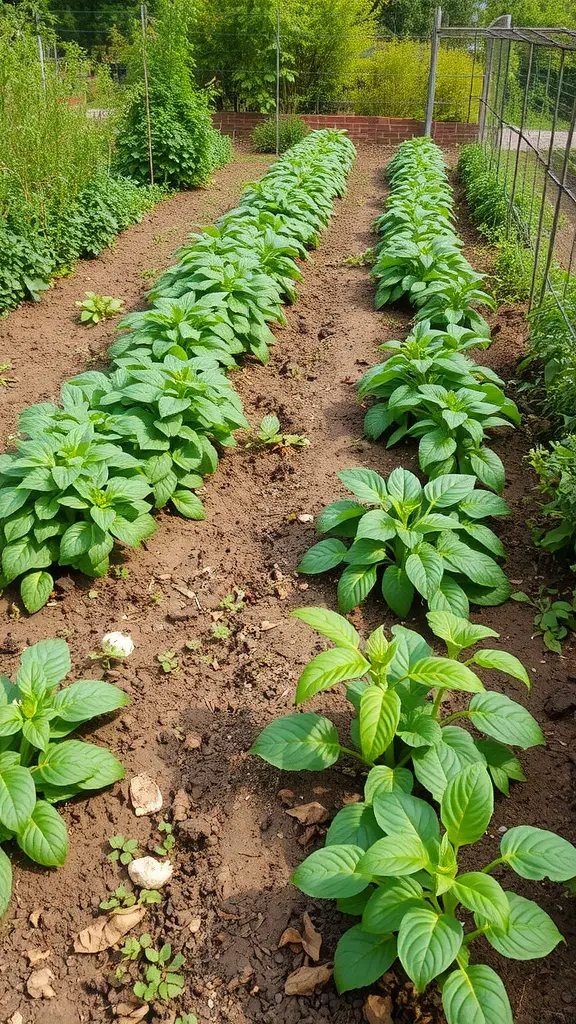
Maximize your kitchen garden’s yield with succession planting, a clever strategy for continuous harvests. This method involves planting various crops sequentially in the same area during the growing season. The photo showcases a meticulously arranged garden bed, featuring rows of vibrant green plants thriving.
Observe the orderly rows of plants. This arrangement is crucial for successful succession planting. Staggering planting times ensures a continuous harvest throughout the season. Consider planting fast-maturing crops, such as radishes or lettuce, alongside slower-growing ones like potatoes.
Succession planting maximizes your garden’s output and boosts soil health. As one crop finishes, another immediately takes over. This continuous cycle ensures a steady supply of fresh produce. It’s an easy way to achieve a larger, more consistent harvest for your kitchen.
Soil Health Improvement Practices
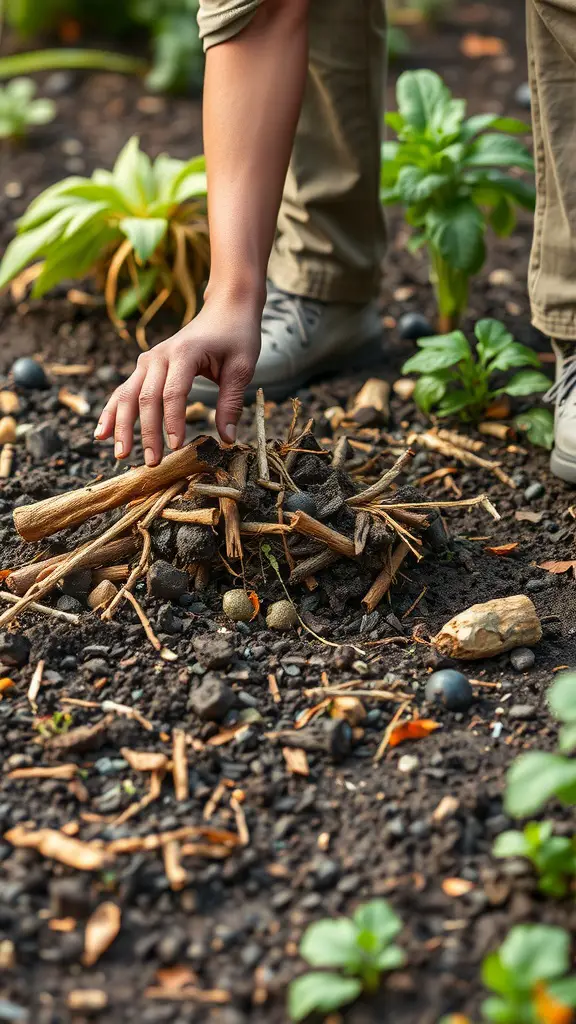
This photo showcases someone working with soil in their kitchen garden. They’re carefully examining a blend of organic matter, including twigs and pebbles. These elements are vital for healthy soil.
Vibrant gardens start with healthy soil. It provides essential nutrients, retains moisture, and anchors plants. Enhance your soil’s health easily by incorporating organic materials such as compost or shredded leaves. This enriches soil structure and fosters a thriving ecosystem of beneficial microbes.
Mulching is another beneficial gardening technique. The individual in the photo seems to be clearing the soil, getting it ready for mulch application by removing bigger pieces of unwanted material. Mulch is great for keeping soil moist and stopping weeds from growing, which leads to healthier plants.
Consistent soil testing and amendments, such as lime or sulfur, are key. These actions improve soil quality, ensuring a thriving and productive garden in 2025.
Composting in Your Kitchen Garden
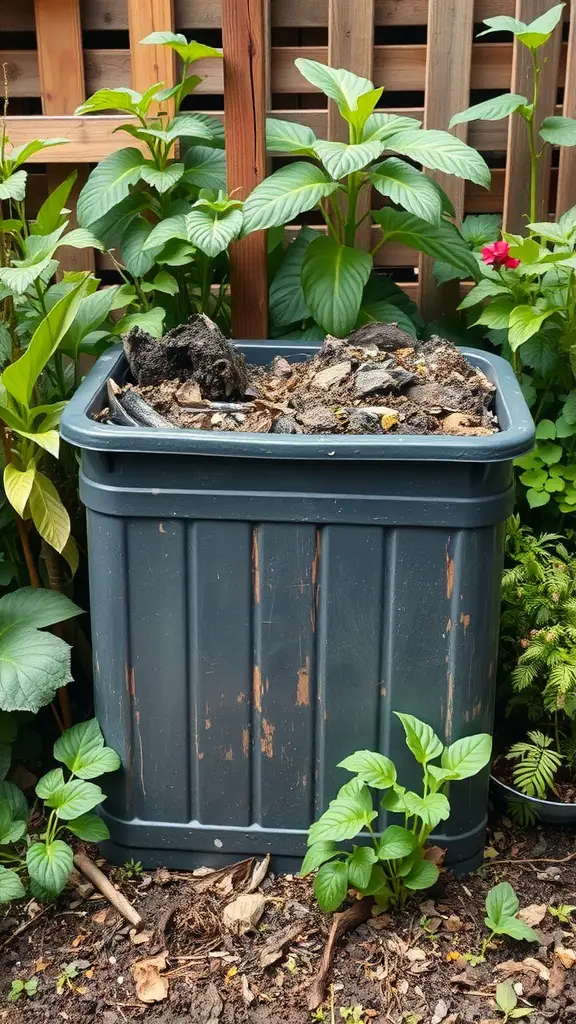
Transform kitchen leftovers and yard debris into valuable plant food through composting. It’s a natural recycling process that enriches your garden soil!
This picture showcases a compost bin brimming with organic waste. Nestled in a flourishing garden, it demonstrates how easily composting integrates into your yard. Healthy plants thrive nearby, highlighting the benefits of this eco-friendly practice.
Your compost bin: a simple container holding immense potential for your garden. Transform kitchen waste – think vegetable trimmings, coffee grounds, and eggshells – into a nutrient-rich mix. This “black gold” will supercharge your plants’ growth and health.
Begin by layering green materials (think fruit and veggie peels) with brown materials (like dry leaves or cardboard). Maintain moisture and turn the pile regularly to accelerate decomposition. Soon, you’ll have nutrient-rich compost, perfect for nourishing your garden in 2025.
Composting significantly improves soil quality and minimizes waste. It’s a beneficial practice for gardeners and the planet alike!
Using Kitchen Scraps for Planting
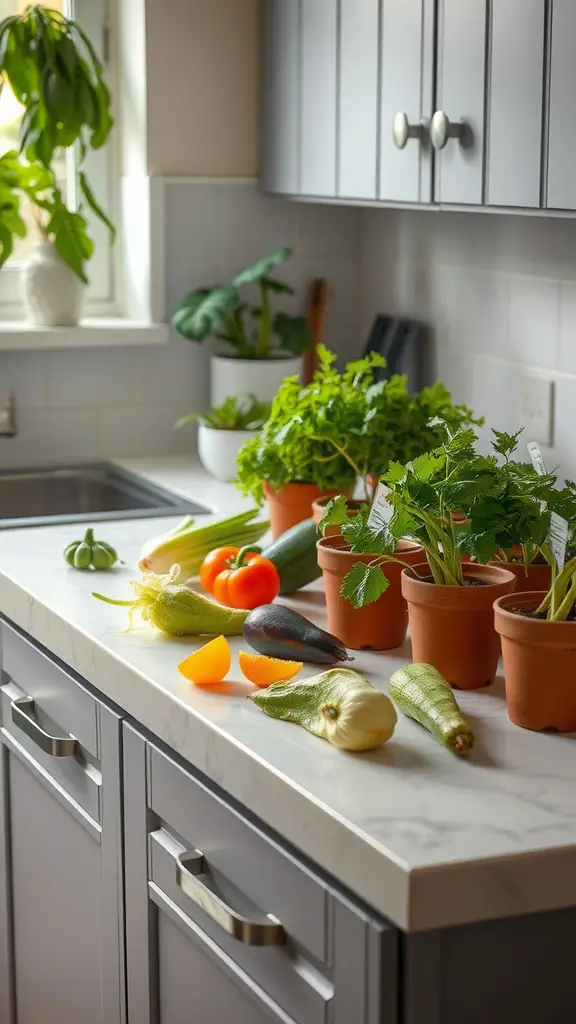
Turning kitchen waste into thriving plants is an enjoyable and sustainable gardening practice. This image showcases various kitchen scraps alongside young seedlings, demonstrating the simplicity of growing new life from food remnants. Updated for 2025, this method remains a top choice for eco-conscious gardeners.
Green onions, for example, easily regrow from their roots. Simply put the white base in water, and new growth appears in days. Tomato seeds can also be dried and replanted. Enjoy homegrown, fresh tomatoes right from your kitchen. Zucchini and peppers displayed on your counter serve as inspiration for your own garden.
Furthermore, propagating herbs such as cilantro and parsley from stem cuttings is highly effective. Just put the cuttings in water until roots appear, then plant them in individual pots. This cost-effective method also provides you with fresh herbs for cooking.
These plant pots suggest a flourishing kitchen garden, easily started with food scraps. Witnessing kitchen waste transform into vibrant plants is truly satisfying. It also adds a touch of nature to your home, enhancing your cooking experience.
Seasonal Plant Selection

Successful kitchen gardens rely on choosing the right plants for each season. This image displays a flourishing garden, brimming with plants suited to their specific growing periods. Sunny yellow tulips reach for the sky, and vibrant zinnias, along with other blossoms, create a joyful atmosphere. These choices provide beauty and draw in helpful pollinators.
Selecting seasonal plants keeps your garden thriving all year. Spring is ideal for planting resilient vegetables such as lettuce and peas. It’s also perfect for colorful flowers. Adapt your planting approach with each season. Summer is a great time to add heat-tolerant crops like tomatoes and peppers.
Blending herbs, veggies, and blooms elevates your garden’s appeal and purpose. Basil and mint boost your cooking and flourish with flowers. Smart planning ensures a smooth seasonal shift. This creates a vibrant, beautiful, and useful outdoor area.
Herb Drying Techniques
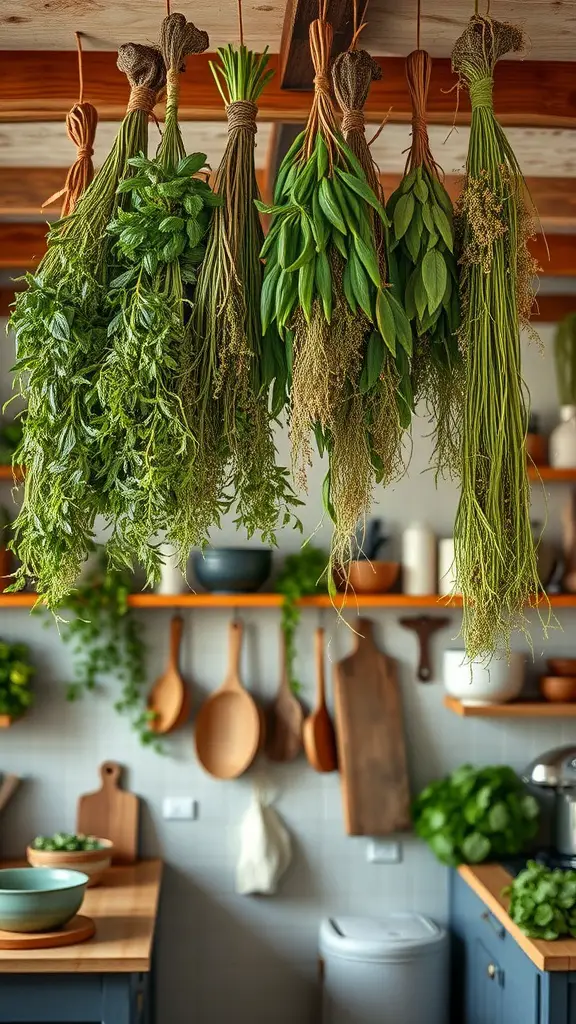
Preserving herbs through drying is an easy method to enjoy their taste and scent year-round. The picture displays a beautiful kitchen where different herbs are suspended from above, demonstrating a traditional and functional drying approach. This method efficiently utilizes space and introduces a delightful, homespun feel to your cooking area.
Harvest fresh, vibrant herbs like basil, thyme, or mint from your garden to begin drying. Bundle the herbs into small groups and secure them with twine. Suspend these bundles upside down in a well-ventilated, warm, and dark space. This promotes proper air flow and inhibits mold growth.
A dehydrator offers another efficient drying solution. Arrange your herbs on the trays. Set the temperature as recommended. Monitor them frequently. They are ready when fully dry and easily crumbled.
After drying, keep your herbs in sealed containers. Store them away from light to preserve their taste. This lets you savor your garden’s flavors well beyond the harvest. Drying keeps herbs fresh and intensifies their taste. They become ideal for cooking and adding flavor to dishes.
Natural Pest Control Methods
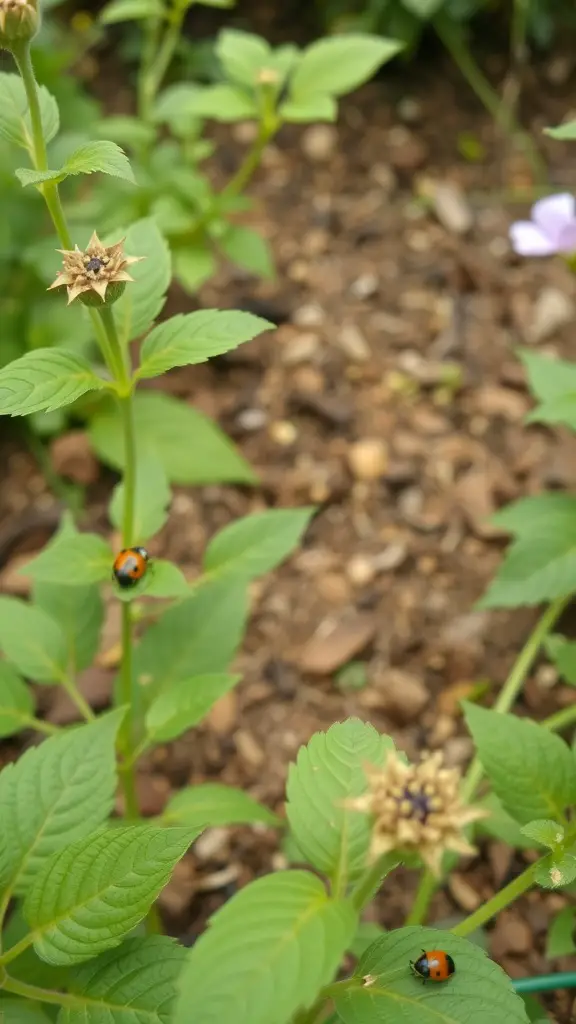
For a thriving kitchen garden, embrace natural pest control. The image showcases ladybugs diligently consuming pests in a vibrant garden. These beneficial beetles are not just visually appealing; they are essential for controlling damaging insects, ensuring a healthy and productive garden in 2025.
Ladybugs are famous for devouring aphids, pests that can severely damage your plants. Releasing these helpful insects into your garden naturally reduces the need for chemical sprays. This straightforward approach promotes a healthy and balanced ecosystem in your own backyard.
Boost your garden’s natural defenses with companion planting! Select plants that draw in helpful insects like ladybugs, or naturally ward off unwanted pests. Marigolds, for example, are fantastic partners for numerous garden vegetables. They effectively repel nematodes and simultaneously attract vital pollinators, fostering a thriving and balanced ecosystem for your plants.
Cultivating a varied garden is also beneficial. Diverse plants disorient pests and interrupt their breeding patterns. This makes it tougher for them to establish themselves. Regularly inspect your plants for pest indicators to address problems promptly. Manually removing pests or using water jets can be quite effective. These methods help your garden flourish without relying on strong chemicals.
Wildlife-Friendly Gardens

Transform your kitchen area by designing a garden that welcomes wildlife. Picture yourself entering a space filled with vibrant flowers, similar to those in the image. Notice the cheerful yellows and delicate pinks, creating a beautiful haven for butterflies and other vital pollinators.
Enhance your garden’s beauty and support local wildlife by planting diverse flora. Nectar-rich flowers are butterfly magnets, ideal for any kitchen garden. This image showcases a butterfly elegantly dancing among blossoms, illustrating the allure of a wildlife-friendly garden.
Think about incorporating native flora into your garden design. They demand less upkeep and attract regional fauna. Arranging plants in groups enhances the habitat for bees and birds. Careful planning results in a vibrant garden. It supports nature and offers fresh produce for your cooking.
Vertical Herb Garden on a Balcony
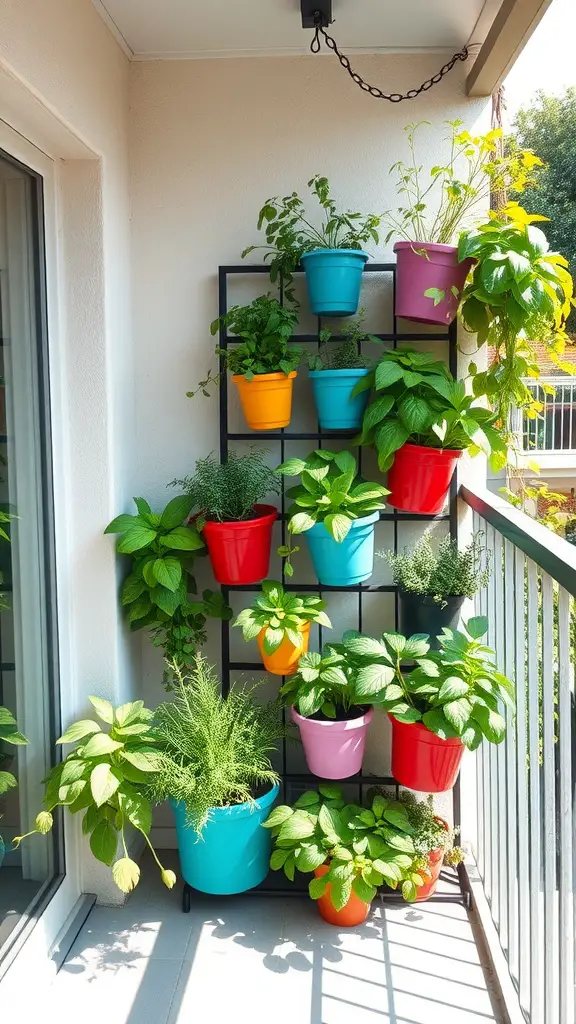
Maximize your small space with a vertical herb garden! It’s a delightful and efficient method for cultivating your preferred herbs. This design showcases vibrant pots neatly organized on a vertical frame, perfectly utilizing balcony space. The bright hues introduce character and enhance the area’s appeal.
Cultivate a diverse herb garden with individual pots for each plant. Enjoy a spectrum of fresh flavors right outside your door. Picture harvesting basil for pasta or mint for tea, all from your balcony! This setup is also incredibly user-friendly, providing easy access to each herb without straining your back.
Maintaining this herb garden is simple. Ensure your plants get ample sunlight and water. Rotate the pots regularly for even light distribution. This vertical garden elevates your culinary experience and infuses your home with natural beauty.
Flowering Vegetables
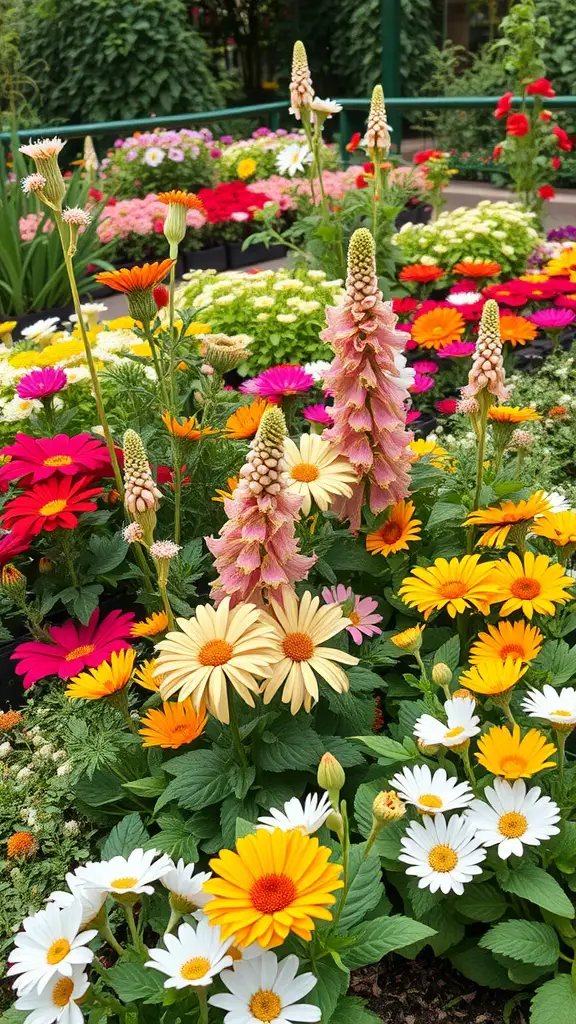
In 2025, flowering vegetables are trending in kitchen gardens! They add vibrant colors and offer tasty produce. Picture strolling through your garden, enjoying beautiful blooms next to your favorite vegetables. It’s a feast for both your eyes and your taste buds!
Numerous vegetables boast edible and visually appealing flowers. Consider squash and zucchini, known for their vibrant yellow blossoms perfect for stuffing or enhancing salads. Similarly, beans and peas offer attractive flowers that draw pollinators, significantly improving your garden’s yield in 2025.
In 2025, elevate your garden design by including flowering edibles. Think vibrant nasturtiums or delicate pansies. They enhance both the visual appeal and taste of your meals. Furthermore, these flowers draw in helpful insects, promoting a healthier garden ecosystem.
For a thriving flowering vegetable garden, adequate sunlight and consistent watering are key. Remove spent flowers regularly to promote further blooming. This practice ensures a vibrant, colorful display alongside a bountiful harvest of fresh vegetables.

